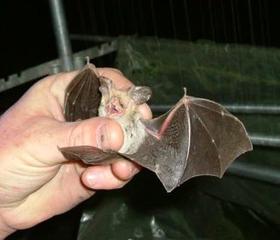Sampling the Nightlife at Hall
6 November 2008

I joined in with several volunteers helping Maree Treadway trap bats at Hall Cemetery recently. Maree is a student at Charles Sturt uni and her project involves surveying many reserves around Canberra with the aim of learning about how suburban development and reserve size impacts on bats.
The traps are a simple design erected in a gap between the trees where the bats might fly. Each trap consists of two square aluminium frames about the size of a house window. Many lengths of fishing line are tightly stretched across each frame – hence the name 'harp traps'. The bats fly into the fishing line and slide unhurt down into a canvas flap at the bottom where they can be retrieved, identified, measured, weighed, checked for signs of pregnancy and then released.
We caught 4 bats in two hours of trapping. Three were the Lesser Long eared Bat which is your classic tiny but fierce looking bat. The highlight came as we were dismantling the last trap only for a bat to fly into it. This proved to be a Chocolate Wattled Bat which again has a tiny body but also features an amusing 'helmeted' head.
We also erected a recording machine called an Anabat. This is a digital recorder which is left on site to record the echo location calls of the bats. Each bat species has a unique frequency 'fingerprint' in its call and once the recording is analysed by a computer it is possible to confirm all of the various species present at each site as well as getting an idea of population size.
The Anabat left at Hall Cemetery recorded 6 species of bats out of the 12 species that are known to live around Canberra. The earliest activity started at 8pm and the last bat was still active at 6 am the next morning!
[Thanks to Greg Hayes for this insight into Hall night life]

